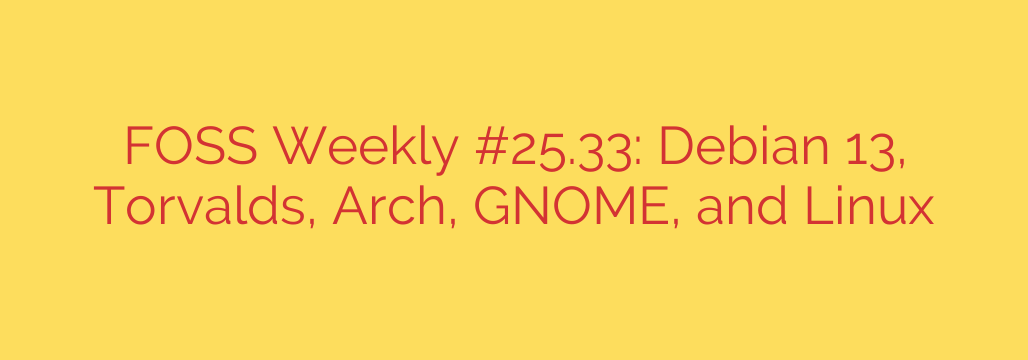
Big Moves in the Linux Universe: What’s New with Debian, Arch, and the Kernel
The open-source world is constantly evolving, and recent weeks have brought a flurry of exciting announcements and developments. From the next major version of a foundational operating system to a groundbreaking shift for a notoriously complex distribution, there’s a lot to cover. Here’s a look at the major news shaping the future of Linux and its ecosystem.
Debian 13 “Trixie” Steps into the Spotlight
The Debian Project has officially revealed the codename for its next major stable release, Debian 13. Following its long-standing tradition of using character names from the Toy Story movies, the next version will be named “Trixie,” after the friendly blue triceratops from Toy Story 4.
With Debian 12 “Bookworm” now firmly established as the current stable release, the development focus has shifted entirely to Trixie. This marks the beginning of a roughly two-year development cycle where new features, updated packages, and significant improvements will be integrated. While it’s still early, the naming is the first official step on the road to what will eventually become the bedrock for countless other distributions, including Ubuntu and its derivatives.
Linus Torvalds on Rust in the Linux Kernel
The integration of the Rust programming language into the Linux kernel has been a hot topic, and Linux creator Linus Torvalds has shared his latest thoughts on the matter. While still proceeding with caution, his outlook is increasingly positive.
Torvalds highlighted the primary benefit of Rust: its ability to prevent entire classes of memory safety bugs, which have historically been a major source of security vulnerabilities in the C-based kernel. However, he also acknowledged the current challenges, noting that the Rust compiler can sometimes produce less-than-ideal output and that seamless interoperability with the existing C code is still a work in progress.
The takeaway is one of cautious optimism. Rust won’t be replacing C overnight, but its potential to improve kernel security and stability is undeniable, and its role is expected to grow as the tooling matures.
Arch Linux Gets a Game-Changing New Installer
Arch Linux has a reputation for being powerful, flexible, and notoriously difficult to install. The manual, command-line-only installation process is a rite of passage for many enthusiasts but a major barrier for newcomers. That is about to change.
The latest official Arch Linux ISO now includes a new, guided installer called archinstall. This text-based user interface (TUI) walks users through the entire setup process, from partitioning and formatting drives to installing a desktop environment and creating a user account.
Key points about the new installer:
- It dramatically lowers the barrier to entry for users who want the power of Arch without the steep learning curve of the manual installation.
- It provides a guided, menu-driven experience for configuring networks, selecting mirrors, and choosing essential software packages.
- The traditional manual installation method is still available for purists and advanced users who want complete control.
This is arguably one of the most significant updates in Arch’s history, making the distribution more accessible than ever before.
A Glimpse into the Future: What’s Coming in GNOME 45
Development is well underway for GNOME 45, codenamed “Riga,” and several exciting enhancements are on the horizon. The next iteration of the popular desktop environment is focusing on refining the user experience and modernizing its core applications.
Some of the key changes to watch for include:
- A new image viewer app, Loupe, is being developed to replace the long-standing “Eye of GNOME.”
- The camera app, Snapshot, is getting a significant overhaul.
- Performance improvements and better compatibility with the Wayland display protocol remain top priorities.
These updates promise a more polished and efficient desktop experience when GNOME 45 is released later this year.
Security Advisory: Watch Out for “Gootloader” Malware
As Linux gains popularity on the desktop, it also becomes a more attractive target for malicious actors. A new malware strain known as “Gootloader” has been observed targeting Linux users. This malware uses a technique called SEO poisoning, where it creates fake forum posts that rank high in search engine results for specific business-related queries.
Unsuspecting users searching for legitimate documents might click on these links, which lead them to download a malicious file. To protect yourself, always follow these security best practices:
- Download software and documents only from official and trusted sources.
- Be skeptical of search results that lead to unfamiliar forums or websites, even if they rank highly on Google.
- Verify the integrity of downloaded files using checksums (like SHA256) when possible.
- Keep your system and applications fully updated to patch known vulnerabilities.
Source: https://itsfoss.com/newsletter/foss-weekly-25-33/








